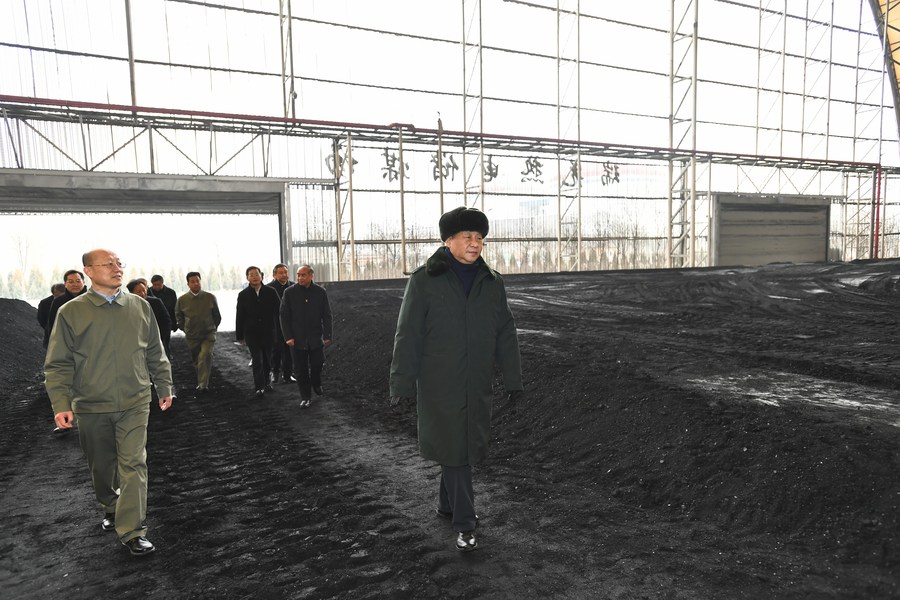
Chinese President Xi Jinping, also general secretary of the Communist Party of China (CPC) Central Committee and chairman of the Central Military Commission, inspects a coal yard of a company that has made progress in the clean and efficient utilization of coal in recent years, in north China's Shanxi Province, Jan. 27, 2022. (Xinhua/Xie Huanchi)
BEIJING, Jan. 30 (Xinhua) -- Chinese President Xi Jinping inspected a thermal power plant on Thursday during his trip to north China's Shanxi Province, his third visit to energy-based enterprises during the past few months.
It followed visits to the Shengli Oilfield in Dongying City, east China's Shandong Province, in October last year, and a chemical enterprise under the China Energy Investment Corporation in Yulin City, northwest China's Shaanxi Province, in September.
These visits shed light on where China's energy development is heading as the country strives to safeguard energy security and pursues a green path to advance energy revolution.
ENERGY SUPPLY VITAL TO PEOPLE'S LIVELIHOOD
During his Shanxi trip, Xi, also general secretary of the Communist Party of China (CPC) Central Committee and chairman of the Central Military Commission, called for strengthening domestic energy production, ensuring the supply of coal and facilitating the clean and low-carbon development of the coal industry.
The supply of power and heat is vital to the overall economic development and social stability, Xi said, urging major enterprises, especially state-owned enterprises, to lead by example in maintaining the stability of supply and prices to ensure that people stay safe and warm in winter.
The words echoed the remarks Xi made when he visited a drilling platform in the Shengli Oilfield last October.
China, as a manufacturing powerhouse, must enhance self-reliance in energy amid efforts to develop the real economy, Xi said during that visit.
It is necessary that coal serves as the main source of energy for a considerable period of time to support the country's modernization, he noted when inspecting Shaanxi in September.
Facing a coal and electricity supply shortage in the third quarter last year, Chinese authorities ramped up energy production and reined in price hikes to secure sufficient energy for factories and support the economy.
China should consolidate the foundation for domestic energy production, ensure coal supply security, and keep steady growth of crude oil and natural gas output, said Xi on Monday while addressing a group study session of the Political Bureau of the CPC Central Committee.
Last year, China's total output of raw coal increased by 4.7 percent year on year to 4.07 billion tonnes, and natural gas output increased by 8.2 percent year on year to 205.3 billion cubic meters.
CARBON GOALS AT STEADY PACE
While coal supply is important to China's development, the clean use of coal is high on the agenda as the country aims to peak its CO2 emissions before 2030 and achieve carbon neutrality before 2060.
While inspecting the power plant featuring clean and efficient utilization of coal in Shanxi, Xi was briefed about the reform progress made in the coal-rich province on energy revolution and the latest developments by local enterprises in the clean use of coal and industrial upgrading.
He called for accelerating green and low-carbon technological breakthroughs and continuously upgrading the industrial structure to achieve the goals of carbon peaking and neutrality proactively and steadily.
"Carbon peaking and carbon neutrality are not something asked of us, but something we are doing on our own initiative," Xi said, adding that the goals cannot be achieved easily, but efforts must be made immediately.
During the September visit to Shaanxi, Xi said the coal industry should follow a green and low-carbon path of development, and coal consumption needs to be transformed and upgraded.
The gradual exit of traditional energy sources should be based on the safe and reliable substitution of new energy sources, Xi said on Monday's group study session.
Cutting emissions is not aimed at curbing productivity or no emissions at all, he noted, stressing that the economic development and green transition should be mutually reinforcing.
While China's economic rise over the past decades was largely powered by coal, the country, now among the world's biggest investors in green energy, is increasing pace to shift to other renewables including wind and solar.
The country has formulated and released a top-level design document for peaking carbon emissions and achieving carbon neutrality, and an action plan for peaking carbon emissions before 2030.
It is necessary to accelerate the development of new energy sources such as wind, solar, biomass and hydrogen energy that have scale and benefits, coordinate hydropower development and ecological protection, and actively develop nuclear power in a safe and orderly manner, Xi said at the group study session.
Efforts should be made to increase the proportion of green and low-carbon sector in the Chinese economy while strictly curbing the blind expansion of energy-intensive, high emission and low-standard projects, noted Xi. ■












